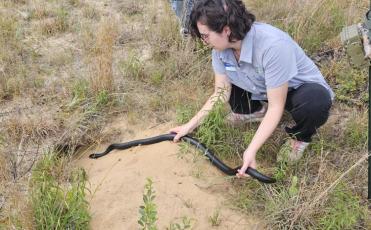
Puck, a servant to Oberon (King of the Fairies) meets a fairy at the beginning of Act II, Scene One of Shakespeare’s “A Midsummer Night’s Dream.” Puck, also known as Robin Goodfellow, is speaking with the fairy when she states, “And I serve the Fairy Queen (Titania), to dew her orbs upon the green.” In this phrase, the fairy is referring to a Fairy Ring.
A “Fairy Ring” pops up throughout history including its depiction in art and literature. These rings are predominantly circular collections of mushrooms. They can be found throughout our environment. English, Celtic, French, and Scandinavian folklore identify these rings as places created by dancing fairies and elves. The mushrooms became places for the fairies and elves to rest. If a human steps inside the ring they endlessly dance until they go mad. It is important to note, I have stepped inside a Fairy Ring and did not fall under a dancing charm.
Fairy Rings, despite their fantastical name, can be a problematic pest to our landscapes – specifically turfgrass. Over the weekend I spotted a small one in my neighborhood. Despite it being a pest, I did get excited to see it because, well, it’s a Fairy Ring! But what are they?
Fairy Rings are the growth of fungi within the soil, specifically types of basidiomycete fungi. The basidiomycete fungi slowly consume organic matter within the soil. These can include logs, twigs, tree stumps, leaves and even turfgrass roots and their thatch. Then, almost simultaneously, the fungi may begin to fruit, producing mushrooms. They erupt from the soil in a circular pattern, usually during our most moist time of year.
These rings will not always impact turfgrass, sometimes the damage is done indirectly to turfgrass. There are three types of Fairy Rings in the landscape. Type one rings cause the soil to become hydrophobic (repels water). This causes the turfgrass within the circular area to die – a dead zone. Type two rings are circular rings where the turfgrass seems to grow quicker and mushrooms may or may not be present. Type three rings have no dead zone or darker circle, just a ring of mushrooms. Damage is usually limited to type one rings.
Usually, no control is necessary for Fairy Rings, unless you have a type one ring. A little bit of fertilizer could help blend the discoloration of the turfgrasses together in a type two ring. Type three rings require no control. Many times the mushrooms associated with Fairy Rings are toxic so it's worth removing the mushrooms if you are concerned about ingestion from a child or animal. Removal could be as simple as cutting them up with the lawn mower. You may also remove them by hand and dispose of them in the trash.
In most situations, Fairy Rings disappear on their own after a couple years. Although it could be worth intervening for type one rings, especially if turfgrass damage is occurring. Aerating and breaking up the soil helps correct type one Fairy Rings. The fungi’s mycelium encapsulates the soil particles, which repels the moisture. The aeration and breaking up of the soil help destroy the mycelium. Afterward, apply a soil-wetting agent and water the ring daily to allow the area to begin to recover. Applications of fungicide can help inhibit the fungus, but it won’t help in the recovery of the dark green rings or turfgrass dead spots.
Be on your guard as you wander through your yard or woods and be sure you do not get trapped in a Fairy Ring, otherwise, you may end up dancing unceasingly or dealing with a dead spot in your landscape. This unique relationship between fungi and plants is one of the millions of ways these two kingdoms interact. Although popping in folklore or literature, be mindful of the Fairy Rings that may pop up in your yard.
If you have any questions about your Florida-friendly landscaping or any other horticulture questions, please reach out to our county extension office and Master Gardener volunteers. You may reach out to the Nassau County Master Gardener volunteers at NassauMGV@ifas.ufl.edu You may also view and register for all our upcoming programs at www.bit.ly/NassauHorticulture
Dr. Taylor Clem is the County Extension Director and Horticulture Extension Agent for UF/IFAS Extension Nassau County. Contact him at taylorclem87@ufl.edu or (904)530-6351.



